This article was co-authored by Deanna Ranlett. Deanna Ranlett is a Pottery and Ceramics Professional and the Owner of Mudfire Inc. in Decatur, Georgia. With more than 22 years of experience in the ceramics industry and eight years of experience owning a studio, they specialize in glaze formulation, firing ceramic and pottery pieces, general clay projects, and screen printing for ceramics. Deanna holds a BFA in Ceramic Arts and Ceramics from Georgia State University.
wikiHow marks an article as reader-approved once it receives enough positive feedback. In this case, several readers have written to tell us that this article was helpful to them, earning it our reader-approved status.
This article has been viewed 265,310 times.
If you have lots of plants, either indoors and outdoors, you may get tired of the basic red of clay pots. Painting clay pots can take a few days due to drying time, but it’s easy and worth it for the added decoration. You’ll soak and scrub the pots before you paint them. It’s also important to seal the pot for moisture and use a primer for a base coat. You’ll be able to paint the pot with simple colors or with intricate designs, as well as seal it to be resistant to outdoor conditions.
Steps
Cleaning the Pot
-
1Sand the pot to smooth any rough spots. Do this outside in the grass, if you can, to reduce cleanup. If you do it inside, or even in a garage, you may want to lay newspaper down so the dust doesn’t get everywhere. It’s also probably best to wear old clothes.
- You don’t need to spend too long on this, just check for any bumps or especially rough spots. If you don’t see anything, then you don’t need to worry about sanding.
- Even if the pot does have bumps, you have the choice of leaving them to add texture to the look after you paint it.
-
2Soak the pot for 1 hour. This is good for new pots because it will loosen any stickers for easier removal. It is also good for pots you have planted in before because it will loosen any dirt. If the pot has no stickers and you can tell for sure it is clean, it may be alright to skip the soak.[1]
- Although you’ll have to leave the pot to dry at various stages in the process, while it soaks, you can use the time to gather your other supplies and set up your paint area.
- If you don’t want to leave it for an hour, check it at 10 minute intervals and if it seems clean to your satisfaction, move forward with the process.
Advertisement -
3Scrub the pot with a brush. While soaking the pot may loosen the dirt, used pots are likely to need a scrubbing to get them completely clean. The paint will not go on even or stick properly if there is any dirt or debris.
- Your pots may need a soft brush so you don’t scratch them too much, but if there are any stubborn spots you can switch to a wire brush for extra strength.
- If you happen to scratch the pot any while brushing it, there’s no need to worry because the paint will cover it and even it out.
-
4Let the pot dry completely. Painting the pot while it is still wet will cause the paint not to stick, so set it out to dry. If it’s a sunny day, put it outside to dry the pot faster. The time it takes to dry may depend on the size of the pot.
- Drying may take a few hours, so plan ahead for this part so you don’t waste your time while you wait.
Sealing and Priming the Pot
-
1Lay newspapers down. If you are working inside on a table or counter, make sure you lay paper, a plastic sheet, or a drop cloth down to protect the surface from paint. Cover the area where the pot will sit and any area you might set paint down.
- If you are painting outside, you may still want to cover hard surfaces so the paint doesn’t stain anything.
-
2Place the pot upside down on a jar. Doing this will keep you from smearing the paint while you hold the pot. You can balance the pot by putting a hand on the bottom (which will now be on top), because the bottom won’t be painted. Use something that is big enough to balance the pot.[2]
- You can use a canning jar, a soup can, a peanut butter jar, or another cylindrical container. The size of jar you’ll need will depend on the size of the pot. If you are painting a large pot, this technique may not be an option.
- This is not mandatory, but it is easier than holding the pot in your hands for the whole time as you paint.
-
3Seal with a waterproof sealer. It’s easiest to use a spray sealer that’s meant for concrete or brick. Since clay pots allow water to soak through, this creates a barrier between the plant and the paint on the outside of the pot. Sealer is usually found in the paint section.[3]
- It’s best to do this outside, or at least in a well-ventilated garage. Spraying this kind of product inside is not safe.
- Drying may take up to 24 hours. Check the product instructions to be sure.
- Seal the inside and outside of the pot. If you don’t seal the inside, when you water the plant the water will soak through the pot and can make the paint loosen and peel off.
- If your pots are decorative and will not have real plants in them, it is not necessary to seal them.
-
4Prime the pot with an all-purpose primer. You can use colored primer if you want to, especially if you want it to work with the paint. Otherwise, a basic white primer is fine. This will help the paint stick to the pot better. Plus, primer helps cover the red color of the clay.
- Prime all around the outside, but also extend the primer at least an inch down the inside of the pot.
- Although some sources say to paint the bottom, it’s best not to put any primer or paint on the bottom of the pot as this can affect proper drainage.
Painting and Sealing the Pot
-
1Use foam brushes to paint the pot. Bristled brushes tend to leave streaks, so using a foam brush will give you a more even coat. You may want a couple brushes of different sizes, especially if you want to paint any kind of patterns on the pot.
- If you have bristled brushes that you want to use, it won’t hurt anything. Foam brushes just work a little better. Bristled brushes are fine for small detail work later on.
-
2Tape off stripes or sections. You can paint the pot one solid color, but for more variety or for fun designs, painters tape is a great option. With this variation, you’ll tape and paint over the tape for the first coat. Once the paint dries, you’ll take the tape off and paint the areas that were under the tape before.
- You can re-tape over the areas you already painted so you keep the lines betweens colors sharp.
- Another option is to paint the entire pot with the first color, and then tape the designs you want and paint again over everything so the parts under the tape will stay the original color.
-
3Paint the outside and 1-2 inches down the inside. You can use any paint you want for the main coats. It’s cheapest to use leftover paint you already have around. Exterior or interior paints are both fine, as well as acrylic craft paint. Spray paint works well,too.[4]
- Cover the entire outside of the pot, excluding the bottom. It’s not necessarily harmful to paint the bottom, but it can’t cause the pot to not drain as well as it should.
- Also paint slightly down the inside because the soil will not go to the very top of the pot, and you most likely don’t want the clay to show.
- There are some paints that will adhere to a ceramic surface that are baked in an oven to set.
-
4Apply extra coats of paint as needed. Depending on the paint, the color, and how thick your first coat was, you may want to apply more than one coat to get an even cover. Clay pots also tend to absorb some of the paint, so it’s likely that one coat won’t be enough.
- Make sure that each coat is dry before you paint any addition coats. If the paint is not dry, new coats will pull the paint off of the pot.
- You can use a different color for the second coat if you want to give the pot a shaded look. If you do this, you might want to thin the second coat with water so it is a little more see-through.
-
5Finish the paint job with designs. Another option for further creativity is painting lines, shapes, or pictures on the pot. If you’ll use the pot for a plant with large foliage that hangs down, you probably don’t want to go into great detail.
- This is where you can make the pot as simple or as detailed as you want. For example, you might want to paint a detailed garden scene or you might want to paint the name of the plant in fancy letters.
-
6Spray the pot with an acrylic sealer. Acrylic sealer will make sure the paint lasts longer without peeling or cracking. This is especially helpful if the pot will be outside in the elements. Wait to put the final seal coat on until all the paint has completely dried.[5]
- This is not mandatory, but your paint job will most likely not last as long if you pass on sealing it.
- You have lots of options when it come to sealants, but pay special attention if you will put the pot outside because not all sealants are meant for all weather.
- Let the pot sit and dry for a few more days before you plant anything in it.
-
7Finished.
Community Q&A
-
QuestionWhat is the use of Modge Podge while making the clay pot?
 Community AnswerWhen decorating clay pots, Modge Podge (or other water-soluble pastes) can be mixed with paint to prevent paint chipping, and provide a glossy finish.
Community AnswerWhen decorating clay pots, Modge Podge (or other water-soluble pastes) can be mixed with paint to prevent paint chipping, and provide a glossy finish. -
QuestionWhat is the best way to drill or expand existing holes without breaking the pot?
 Community AnswerUse an electric drill with a masonry bit. Start slowly and increase speed and pressure as needed. Be patient.
Community AnswerUse an electric drill with a masonry bit. Start slowly and increase speed and pressure as needed. Be patient. -
QuestionIs there a particular type of paint to use?
 Community AnswerYou can use any paint you want. I use acrylic craft paint and sometimes add metal looking highlights with markers, paints, and rubs (silver, gold, brass, copper, whatever you want). I start with a clean pot and apply acrylic craft paint as my background and artwork. That's it! Acrylic paint is thick so you need to add water to get the desired consistency. Less water = thicker paint which doesn't soak into the clay. More water = thinner paint which is great for designs and shading. Just play with it, and you'll find what works for you.
Community AnswerYou can use any paint you want. I use acrylic craft paint and sometimes add metal looking highlights with markers, paints, and rubs (silver, gold, brass, copper, whatever you want). I start with a clean pot and apply acrylic craft paint as my background and artwork. That's it! Acrylic paint is thick so you need to add water to get the desired consistency. Less water = thicker paint which doesn't soak into the clay. More water = thinner paint which is great for designs and shading. Just play with it, and you'll find what works for you.
Things You'll Need
- Sandpaper
- Newspapers
- Bucket or tub for soaking
- Brush
- Empty jar or cylindrical container
- Clay pots
- Waterproof sealer
- Primer
- Tape, painter’s or masking
- Paint
- Foam paint brushes
- Acrylic sealer
References
- ↑ http://www.finegardening.com/painting-clay-pots
- ↑ http://www.practicallyfunctional.com/how-to-seal-painted-flower-pots/
- ↑ http://www.patriciaspots.com/howtopaintapot.htm
- ↑ http://www.sandandsisal.com/2014/05/how-to-paint-terracotta-pots.html
- ↑ http://www.prettyprudent.com/2010/08/hot-mess/tips/confessions-of-an-adhesive-sealant-junkie-2/
About This Article
To paint clay pots, start by sanding the surface, then wash the pot and let it dry completely. Next, apply a waterproof sealer to the exterior, followed by a coat of all-purpose primer. Then, apply a coat of acrylic paint in the color of your choice with a foam brush. If you want to make the color look more vibrant, you can add additional coats of paint, letting each coat dry completely before adding a new one. Finally, apply an acrylic sealer to lock in the color and prevent the paint from peeling or cracking. To learn about using masking tape to create different designs, read on!
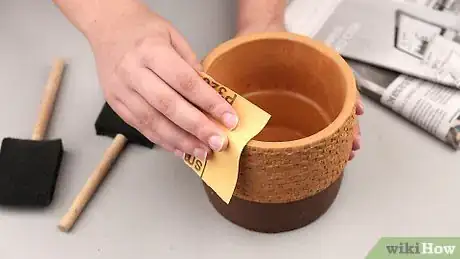
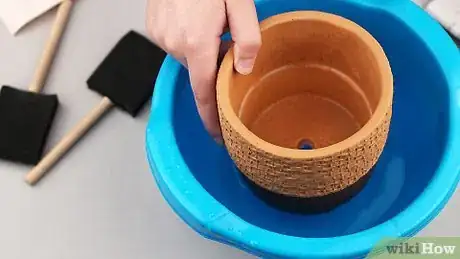
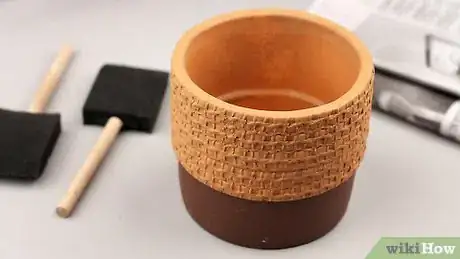
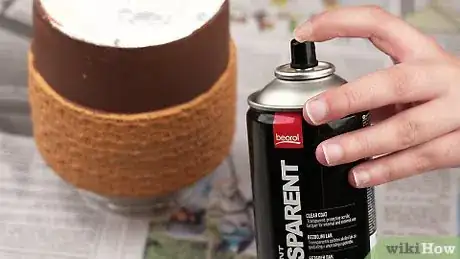

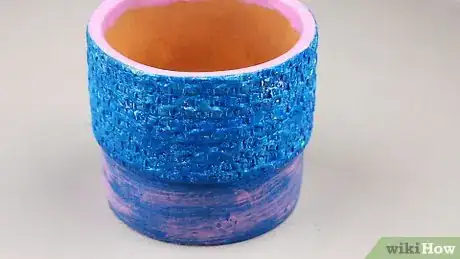






-Oven-Step-15.webp)















































